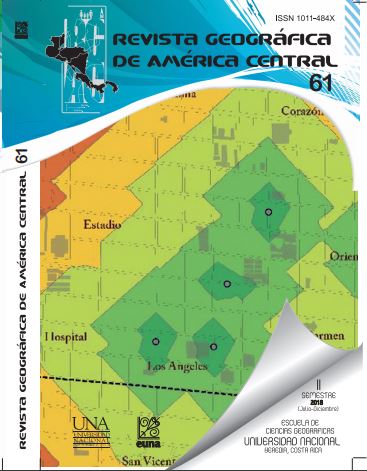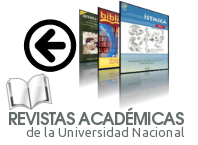Indicators of Proximity to Urban Services in Heredia City, Costa Rica
DOI:
https://doi.org/10.15359/rgac.61-2.6Keywords:
Keywords: proximity, accessibility, services, distance, distribution of the population., proximidad, accesibilidad, servicios, distancia, distribución de poblaciónAbstract
This research article considers the quantification of the access that residents of the city of Heredia have to some basic services in the city, taking as reference the distance to which the residents live, calculating what percentage of the population resides at 100, 250, 500, 750, 1000 m and more than 1000 m away from the location of the services. The results obtained show heterogeneous access to services by the residents of the city, which is expected in an urban area that has grown and evolved in response to economic and commercial interests, without the intervention of an entity to plan and regulate the activities based on the well-being of the resident population.
References
Agencia de Ecología Urbana de Barcelona. (2010). Plan de Indicadores de Sostenibilidad Urbana de Vitoria-Gasteiz. Barcelona, España
Ayuntamiento de Sevilla. (2008). Plan Especial de Indicadores de Sostenibilidad Ambiental de la Actividad Urbanística de Sevilla, Barcelona, España.
CAT-MED (Plataforma). (2009). Urban Empathy. Recuperado de http://www.catmed.eu/dic/es/61/proximidad-a-servicios-basicos.
Comisión Económica para América Latina. (CEPAL). (2000). Servicios urbanos y equidad en América Latina. Un panorama con base en algunos casos. División de Medio Ambiente y Asentamientos Humanos. Santiago, Chile.
Chevalier, S., Choiniere, R. y Bernier, L. (1992). User guide to 40 Community Health Indicators. Ottawa, Community Health Division. Health and Welfare Canada. Ottawa, Canadá
Del Campo, A., García, F. y Flores, M. (2009). Proceso de Peatonización y Nueva Sociabilidad. Centro de Estudios Andaluces. Sevilla, España.
Ley 4240 de Planificación Urbana. (1962). República de Costa Rica. San José, Costa Rica.
Organization for Economic Co-Operation and Development. (OECD). (2000). Competition in Local Services: Solid Waste Management. Competition Policy Roundtables, ORGANISATION FOR ECONOMIC CO-OPERATION AND DEVELOPMENT.
Pérez-Foguet, A. (2005). Asentamientos Humanos e Infraestructuras de Servicios Urbanos. Associació Catalana d’ Enginyeria Sense Fronteras. Barcelona, España.
Downloads
Published
How to Cite
Issue
Section
License
Proposed policy for journals offering Open Access
Authors publishing their works in the Journal acknowledge and agree to the following terms:
a) Authors retain the copyrights to their works and guarantee the Journal the right to be the first to publish their works, under the Creative Commons License Attribution-NonCommercial-ShareAlike 4.0 International, CC BY-NC-SA 4.0 International (https://creativecommons.org/licenses/by-nc-sa/4.0/deed.es), which allows others to share works upon complying with the acknowledgment of authorship and mention of the Journal as the original publisher of the work.
b) Authors are permitted to separately establish additional agreements for the non-exclusive distribution of the official edition of the work published in the Journal (for example, authors may desire to place the work in an institutional repository or incorporate it into a book that is to published elsewhere) so long they acknowledgment to recognize the Journal as the original publisher. The aforementioned additional agreements must respect the terms of the non-profit character and sharing philosophy of the original license (CC BY-NC-SA 4.0 International, https://creativecommons.org/licenses/by-nc-sa/4.0/deed.es).
c) Authors are encouraged to archive the post-print or editor/PDF version in Open Access repositories.







 REVGEO is licensed under https://creativecommons.org/licenses/by-nc-sa/4.0/deed.es
REVGEO is licensed under https://creativecommons.org/licenses/by-nc-sa/4.0/deed.es
.svg_4.png)

_(1).png)
_(1)_(1)_(1)_1.png)
(2)(1)(1)(1).png)
